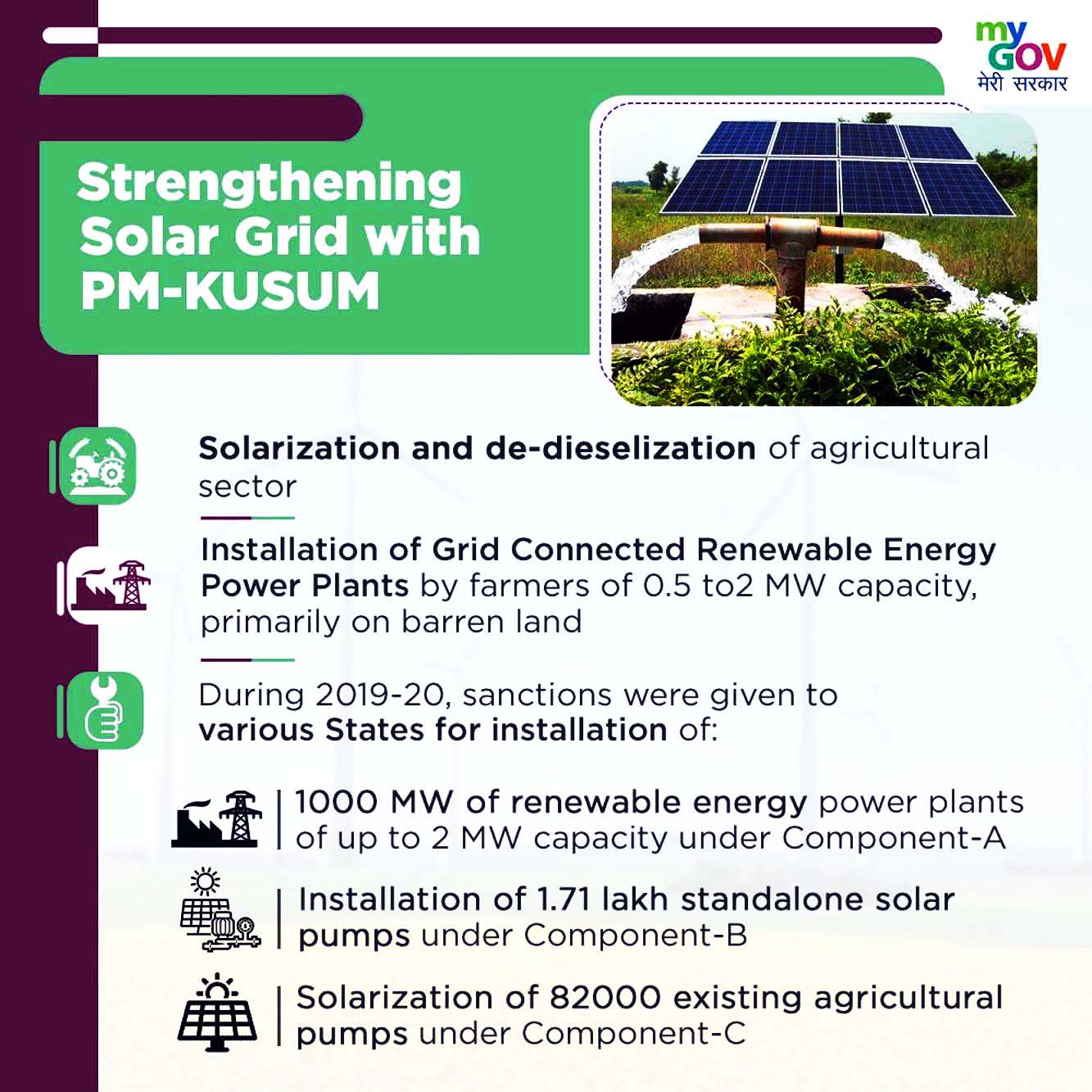Agriculture
PM-KUSUM
This article is based on “PM-KUSUM will shine when implemented fully” which was published in The Hindu Business line on 12/12/2020. It talks about the prospects of the Kisan Urja Suraksha evam Utthaan Mahabhiyan (KUSUM) scheme.
The farmer focus of Budget 2018 has given a fillip to the farmer-oriented scheme involving decentralised solar power production up to 28,250 MW, known as Kisan Urja Suraksha evam Utthaan Mahabhiyan (KUSUM) scheme.
The KUSUM scheme would provide additional income to farmers, by giving them the option to sell additional power to the grid, through solar power projects set up on their barren lands.
If implemented well, the PM-KUSUM scheme can be the ultimate game-changer for energy security and the rural economy in India.
Component of the PM-KUSUM
PM-KUSUM consists of three components and aims to add a solar capacity of 30.8 GW by 2022:
- Component-A: 10,000 MW of decentralised ground-mounted grid-connected renewable power plants.
- Component-B: Installation of two million standalone solar-powered agriculture pumps.
- Component-C: Solarisation of 1.5 million grid-connected solar-powered agriculture pumps.
Intended Benefits of the Scheme
- Helping Discoms: Electricity for agriculture is highly subsidised and is often termed as the main cause for rapid groundwater depletion and poor financial position of Discoms.
- This scheme will support the financial health of Discoms by reducing the burden of subsidy to the agriculture sector.
- Helping States: The scheme will promote decentralised solar power production, and reduce transmission losses.
- For state governments, this is a potential way to reduce their subsidy outlay towards irrigation.
- Apart from it, the scheme will help States meet the RPOs (renewable purchase obligation) targets.
- Helping Farmers: If farmers are able to sell surplus powers, they will be incentivised to save power and, in turn, it will mean the reasonable and efficient use of groundwater.
- This may also provide water security to farmers through the provision of assured water sources through solar water pumps — both off-grid and grid-connected.
- Helping Environment: Another intended benefit of this scheme will result in the expansion of the irrigation cover by providing decentralized solar-based irrigation and moving away from polluting diesel.
- This should also fill the void in solar power production in the intermediate range between rooftops and large parks.
Associated Concerns
- Logistics Issue: There is a matter of domestic availability of equipment itself. While pumps are not a challenge for domestic suppliers, the availability of solar pumps is still an issue.
- Further, due to the strict DCR (Domestic Content Requirements), the suppliers of solar equipment have to raise the domestic cell sourcing. However, there isn’t enough domestic cell manufacturing capacity.
- Omission of Small and Marginal Farmers: There has been the relative omission of small and marginal farmers, as the scheme focuses on pumps of 3 HP and higher capacities.
- It is due to this, solar pumps are not reaching the majority of farmers, as nearly 85% of them are small & marginal.
- Also, the reality of low water tables, especially in North India and parts of South India, which make small-sized pumps limiting for the farmer.
- Depleting Water Tables: Due to power subsidies, the recurring cost of electricity is so low that farmers keep on pumping water and the water table is going down.
- In a solar installation, it becomes a more difficult job to upgrade to higher capacity pumps in case the water table falls because you will have to add new solar panels which are expensive.
Way Forward
- Bring States Together: Consensus between the Centre and States is the key to the success of this decentralised solar power scheme.
- Any reform in India’s power space cannot take place unless there is consensus between the Centre, States and stakeholders. Till then, it will be like a half-baked cake.
- Sustainable Farming: Apart from switching to solar power, farmers should also switch over to drip irrigation mode which saves water and power with increased crop output.
- Lucrative Solar Energy Pricing: For effective implementation and serious participation by stakeholders, the scheme should be more attractive in terms of benchmark prices in view of the challenges on account of higher costs of implementation and comprehensive maintenance.
Conclusion
The PM-KUSUM scheme, like many government schemes, is certainly well-intentioned, but policy interventions like manufacturing in India for solar cells, or even phasing out power subsidies, might give it the legs to deliver on its promise.
|
Drishti Mains Question PM KUSUM scheme is capable of changing the energy dynamics of Indian agriculture. Critically Analyse. |
This editorial is based on “Time for India’s net zero target” which was published in The Economic Times on December 13th, 2020. Now watch this on our Youtube channel.





